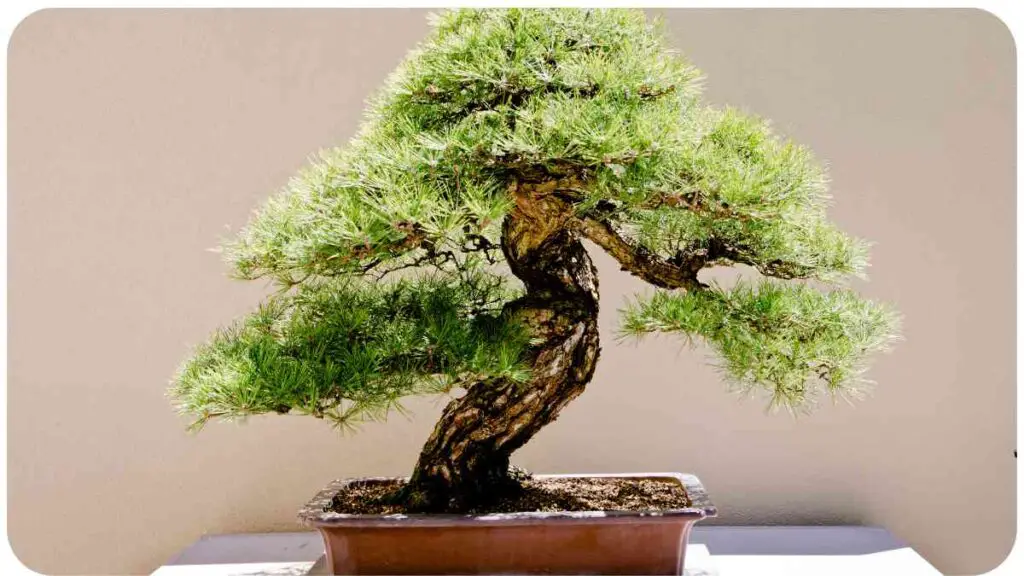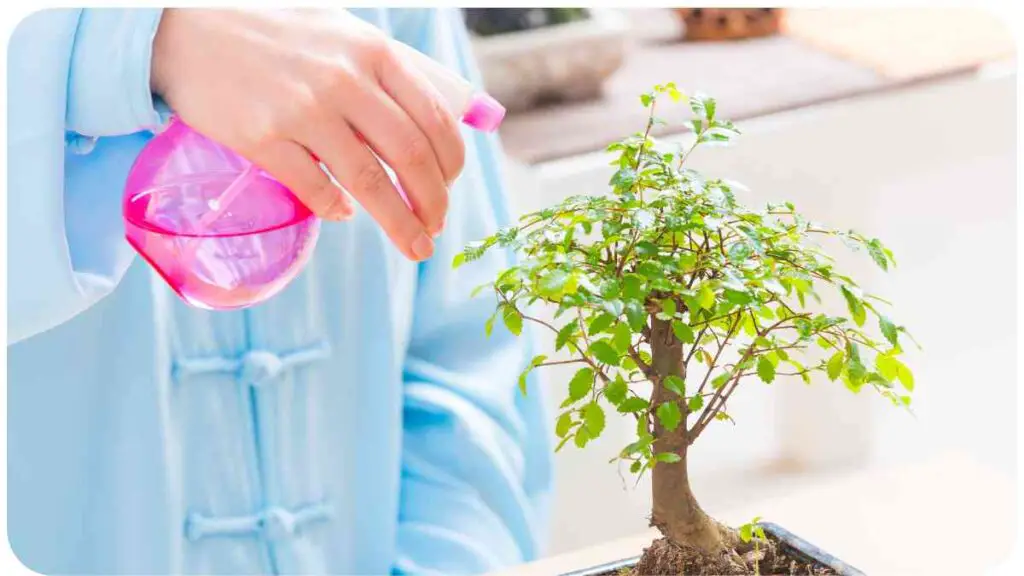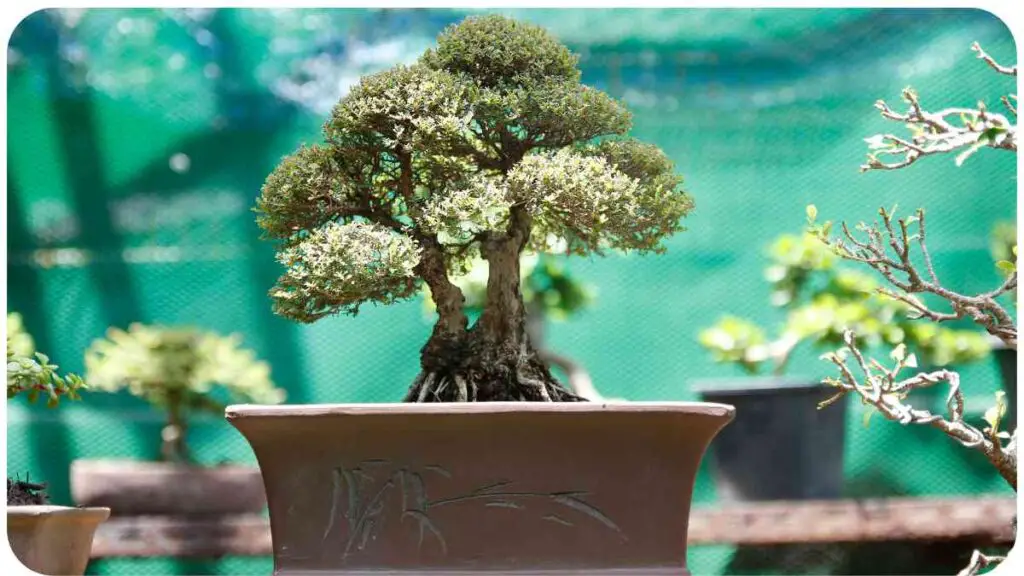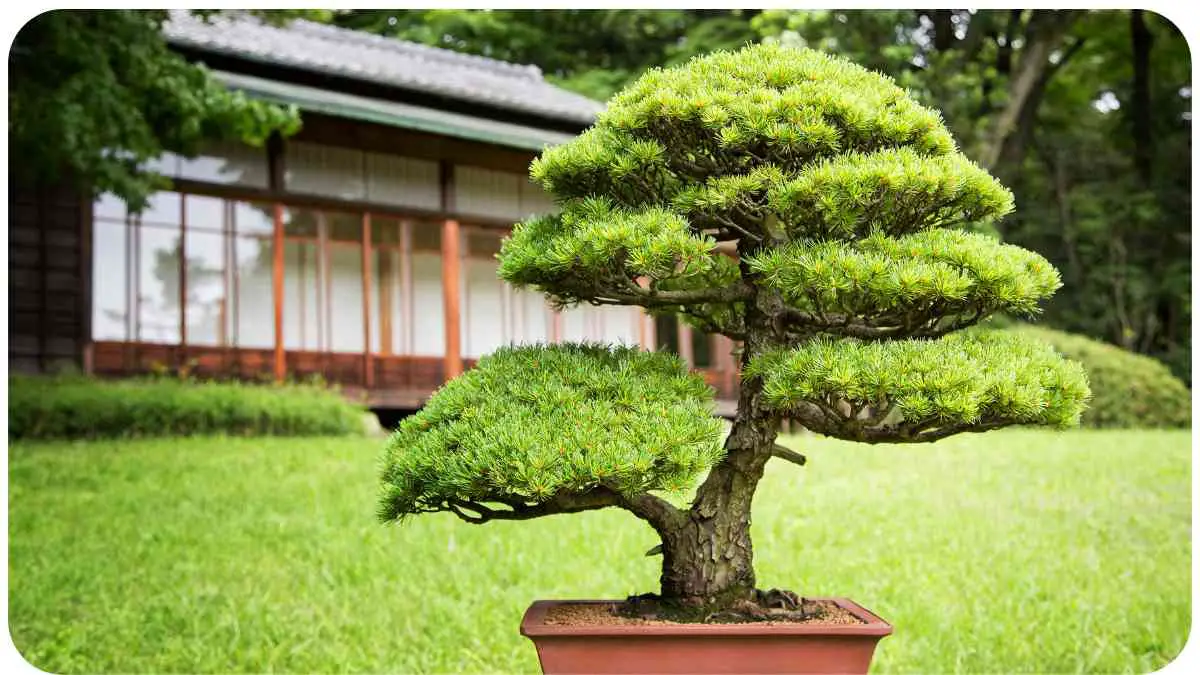Bonsai trees are marvels of nature and artistry, captivating enthusiasts with their miniature beauty and timeless appeal. But have you ever wondered how these delicate specimens manage to thrive for centuries in tiny pots?
In this article, we delve into the secrets behind the longevity of bonsai trees, exploring the meticulous care and techniques that ensure their survival.
| Takeaways |
|---|
| 1. Bonsai trees thrive for centuries in small pots due to meticulous care and cultivation techniques. |
| 2. Root pruning, soil composition, watering, and light requirements are key factors in bonsai tree survival. |
| 3. Proper pruning and training techniques help shape and maintain the aesthetic appeal of bonsai trees. |
| 4. Vigilant pest and disease management is essential for keeping bonsai trees healthy and resilient. |
| 5. Bonsai cultivation requires patience, dedication, and a lifelong commitment to learning and growth. |
2. The Art of Bonsai Cultivation

Before we unravel the mystery of bonsai tree survival, it’s essential to understand the artistry and dedication that goes into cultivating these miniature masterpieces. Bonsai, originating from the Chinese term “penzai,” meaning “tray planting,” is a centuries-old practice of growing and shaping trees in containers. It requires patience, skill, and a deep appreciation for nature’s beauty.
Exploring the intricate secrets of bonsai longevity reveals a delicate balance of care and patience. Through centuries-old techniques, bonsai masters have preserved miniature marvels, proving that beauty thrives in confinement.
The Importance of Root Pruning
One of the fundamental practices in bonsai cultivation is root pruning. By periodically trimming the roots, bonsai enthusiasts prevent them from becoming pot-bound, allowing for continued growth and health. This meticulous process involves carefully removing excess roots while preserving the essential root structure necessary for nutrient uptake.
| Benefits of Root Pruning | Techniques for Root Pruning |
|---|---|
| 1. Promotes healthy root growth | 1. Air Pruning |
| 2. Prevents root circling | 2. Root Raking |
| 3. Maintains appropriate pot size | 3. Root Trimming |
Techniques for Container Selection
Choosing the right container is crucial for the well-being of bonsai trees. Containers should provide adequate drainage and space for root growth while complementing the tree’s aesthetic qualities. From traditional ceramic pots to innovative designs crafted from natural materials, there’s a myriad of options available to suit every bonsai enthusiast’s preference.
Discover the physiological phenomenon behind pruney digits, an intriguing side effect of prolonged water exposure. Unraveling the science of wrinkles sheds light on the body’s response to moisture, offering insights into the mysteries of human physiology. From fingertips to toes, understanding this quirk of biology adds depth to our understanding of the human body.
| Container Materials | Pros | Cons |
|---|---|---|
| Ceramic | Classic appearance | Heavy, prone to breakage |
| Plastic | Lightweight, affordable | Less aesthetic appeal |
| Wooden | Natural look | Susceptible to rot |
3. Understanding Bonsai Tree Survival
Now that we’ve explored the artistic side of bonsai cultivation, let’s dive into the nitty-gritty of how these miniature trees manage to thrive in confined spaces.
Soil Composition and Drainage
The soil composition plays a vital role in the health and longevity of bonsai trees. Bonsai soil should provide adequate drainage while retaining moisture and nutrients essential for plant growth. A well-draining mix typically consists of a combination of organic and inorganic components, such as akadama, pumice, and lava rock.
| Components | Benefits |
|---|---|
| Akadama | Excellent drainage |
| Pumice | Lightweight, porous |
| Lava Rock | Improves aeration |
4. Watering and Feeding Bonsai Trees

Proper watering and feeding are essential for the health and vitality of bonsai trees. Understanding the specific needs of your tree species and adjusting your watering and fertilization practices accordingly is key to ensuring its long-term survival.
Pruning, a horticultural art form, unlocks the hidden potential within plants. Understanding growth-boosting techniques illuminates the path to flourishing foliage and compact designs. Mastery of the shears yields miniature masterpieces, a testament to the symbiotic relationship between plant and pruner.
Frequency and Timing
Bonsai trees should be watered when the soil begins to dry out but before it becomes completely parched. The frequency of watering varies depending on factors such as the tree species, environmental conditions, and the type of soil mix used. It’s essential to observe your tree closely and develop a watering routine that suits its individual needs.
| Bonsai Watering Tips |
|---|
| 1. Check soil moisture regularly |
| 2. Water thoroughly until excess drains out |
| 3. Adjust watering frequency based on season |
Fertilization Practices
Fertilizing bonsai trees provides them with essential nutrients needed for growth and development. Using a balanced fertilizer formulated specifically for bonsai trees helps maintain their health and vigor. However, it’s crucial not to over-fertilize, as this can lead to root burn and other issues.
| Fertilization Tips |
|---|
| 1. Use a balanced fertilizer |
| 2. Apply fertilizer during the growing season |
| 3. Dilute fertilizer to avoid overfeeding |
5. Light and Temperature Requirements
Bonsai trees require adequate light and consistent temperatures to thrive. Understanding their specific requirements and providing the right conditions is essential for their overall health and vitality.
Finding the Right Balance
Bonsai trees typically require ample sunlight to photosynthesize and grow vigorously. However, excessive exposure to direct sunlight can lead to sunburn and heat stress, while insufficient light can result in weak growth and leggy branches. Finding the right balance of light is crucial for the health and development of bonsai trees.
| Light Requirements |
|---|
| 1. Place bonsai trees in bright, indirect light |
| 2. Rotate trees regularly to ensure even growth |
| 3. Provide shade during the hottest part of the day |
Seasonal Adjustments
Adjusting light and temperature conditions according to the seasons is essential for bonsai tree care. While most bonsai trees are outdoor plants that require exposure to natural sunlight, some species may benefit from protection during extreme weather conditions.
| Seasonal Care Tips |
|---|
| 1. Protect bonsai trees from frost and freezing temperatures |
| 2. Provide adequate ventilation during hot summer months |
| 3. Monitor moisture levels closely in winter to prevent drying out |
6. Pruning and Training Bonsai Trees
Pruning and training are essential techniques for shaping and styling bonsai trees, enhancing their aesthetic appeal and overall structure.
Shaping and Styling Techniques
Pruning involves selectively removing branches, foliage, and roots to achieve the desired shape and form. By regularly pruning your bonsai tree, you can encourage ramification and refine its silhouette over time.
| Pruning Techniques |
|---|
| 1. Branch pruning to maintain shape and balance |
| 2. Root pruning to encourage growth and development |
| 3. Foliage pruning to improve ramification |
Tools of the Trade
Having the right tools is essential for successful bonsai pruning and training. From concave cutters to knob cutters, each tool serves a specific purpose in the bonsai enthusiast’s arsenal.
Delve into the world of bonsai basics to grasp the essence of miniaturization. Unveiling secrets of scale demystifies the artistry behind creating captivating miniature landscapes. From root to canopy, bonsai artisans sculpt living sculptures that transcend size, embodying nature’s grandeur in a compact form.
| Essential Bonsai Tools |
|---|
| 1. Concave cutters for clean branch cuts |
| 2. Knob cutters for removing large knobs and roots |
| 3. Wire cutters for shaping and styling with wire |
7. Disease and Pest Management
Despite the careful attention bonsai trees receive, they are still susceptible to pests and diseases. Vigilant monitoring and prompt action are essential for keeping these miniature masterpieces healthy and thriving.
Common Issues and Solutions
Some of the most common bonsai tree pests and diseases include aphids, scale insects, and fungal infections. Identifying the problem early and implementing appropriate treatment measures can prevent further damage and ensure the tree’s survival.
| Pest and Disease Management |
|---|
| 1. Regularly inspect leaves and branches for signs of pests |
| 2. Treat infestations with insecticidal soap or horticultural oil |
| 3. Provide proper airflow and avoid overwatering to prevent fungal infections |
Preventative Measures
Preventing pests and diseases is often easier than treating them. Practicing good bonsai hygiene, such as regularly cleaning and disinfecting tools, and avoiding stress-inducing factors, can help keep your bonsai trees healthy and resilient.
| Preventative Tips |
|---|
| 1. Quarantine new bonsai trees to prevent introducing pests |
| 2. Maintain proper soil moisture and drainage |
| 3. Remove dead or diseased branches promptly |
8. Patience and Persistence: The Key to Bonsai Success

Bonsai cultivation is a journey that requires patience, dedication, and a willingness to learn from both successes and failures. While it may take years or even decades to create a masterpiece, the rewards of nurturing a bonsai tree are immeasurable.
The journey from sapling to miniature masterpiece involves meticulous cultivation and care. Exploring bonsai cultivation unveils the methods behind shaping majestic trees into diminutive wonders. Through centuries-old techniques passed down through generations, bonsai enthusiasts nurture nature’s beauty within confined spaces.
9. Conclusion
In conclusion, the longevity of bonsai trees in small pots is a testament to the skill and dedication of bonsai enthusiasts worldwide. By understanding the intricate balance of root pruning, soil composition, watering, light, and temperature requirements, as well as practicing diligent pruning and pest management, anyone can enjoy the beauty and tranquility of these miniature marvels for years to come.
Remember, bonsai cultivation is not just a hobby it’s a lifelong journey of growth and discovery.
Further Reading
- Bonsai Empire: Bonsai History: Explore the rich history and origins of bonsai cultivation, tracing its roots back to ancient China and Japan.
- NDSU: Bonsai Trees: Delve into this comprehensive guide to bonsai trees, covering everything from basic care tips to advanced pruning techniques.
- Encyclopedia Britannica: Bonsai Horticulture: Gain a deeper understanding of bonsai horticulture with this informative article from Encyclopedia Britannica, exploring the principles and practices of cultivating these miniature masterpieces.
FAQs
How long can a bonsai tree live?
Bonsai trees have the potential to live for centuries with proper care and maintenance. Some ancient bonsai specimens are over 1,000 years old.
What types of trees are suitable for bonsai?
A wide variety of tree species can be cultivated as bonsai, including juniper, pine, maple, and ficus. The choice of species depends on factors such as climate, growing conditions, and aesthetic preferences.
How often should I water my bonsai tree?
The frequency of watering bonsai trees depends on factors such as the tree species, pot size, soil composition, and environmental conditions. It’s essential to monitor the soil moisture levels and water accordingly, ensuring the soil doesn’t dry out completely or become waterlogged.
Can bonsai trees be kept indoors?
While some bonsai species can thrive indoors with proper care, most prefer outdoor conditions with ample sunlight and airflow. Indoor bonsai cultivation requires attention to factors such as light, temperature, humidity, and ventilation to ensure the tree’s health and vitality.
How do I know when to repot my bonsai tree?
Bonsai trees should be repotted periodically to refresh the soil, prevent root binding, and promote healthy growth. Signs that indicate it’s time to repot include roots protruding from the drainage holes, slow growth, and declining health. Repotting is typically done every one to three years, depending on the tree’s age and growth rate.

For 15 years, Hellen James has worked in the gardening industry as an expert and landscape designer. During her career, she has worked for a variety of businesses that specialize in landscaping and gardening from small firms to large corporations.

